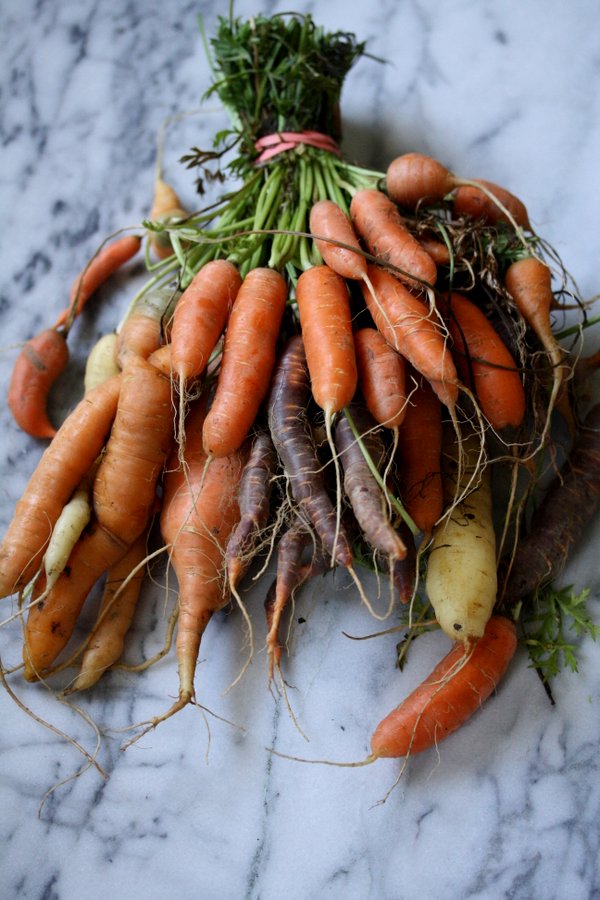
I could write a book on all the issues surrounding the question of what to eat, including all the crazy and conflicting opinions I’ve gotten from my doctors over the years. But since there are about 5,000 people who have already done that, I wanted to instead focus on two important questions that are an ongoing struggle in both my work, and my daily life: how do you nurture home cooking as a habit, and how do you make buying higher quality ingredients more affordable?
The place where everything always comes together for me is the kitchen (duh). But home cooking is easier said than done. The first step for most people is breaking a lifelong love affair with takeout and packaged foods, something even I struggle with as a self-proclaimed lazy cook with Seamless Web constantly at my fingertips. Then, in order to make healthy home cooking more affordable, the second must I’ve discovered is that you have to learn to live with meals that aren’t centered around animal products.
The experiments I came up with were a 2-week microwave ban, followed by 2 weeks of following Mark Bittman’s protocol of eating Vegan Before 6pm. Finally, with those two warm-up laps under my belt I wanted to put my new semi meat-free cooking prowess to the test by seeing how far I could stretch $40 at the Farmer’s Market.
As a private chef, I’ve had a lot of practice cooking many make ahead meals in a single afternoon. Aside from the unlimited budget aspect (thank you, client), I’ve basically been doing this challenge every Tuesday for the last three years. But I’d never tried it with organic as a focus, and never as the person who was actually eating the meals.
When I meet new people or see old acquaintances, I often get asked “so do you, like, cook dinner for yourself every night?” To which I reply um, no. The idealized portrait of a healthy food blogger is not all that different from The Minimalist Pixie Dream Girl, just replace the white couch with a white marble countertop and throw a strappy linen apron on top of that loose button down, and you have the angelic face of food lifestyle porn.
I am not that person.
If my life was actually an on-going Lightroom slideshow of morning smoothies, bespoke carrots, and relaxed afternoons reading Bon Appetit on the couch, then I wouldn’t need a year’s worth of healthy experiments to help me feel like less of a mess. If my sink didn’t contain 5 crusty soup bowls at any given moment, the microwave challenge wouldn’t have been so scary. And if I cooked dinner for myself every night, as so many people assume, my body’s cells wouldn’t consist of 20 percent Pad Thai.
The truth is, I so often let my professional time logged in the kitchen detract from my own healthy habits at home. This month I wanted to see if I could make the type of cooking I preach on this site, an actual ritual for myself. And see whether it would be stronger than the ritual of eating a bag of tortilla chips with hummus after a long day of work and calling it dinner.
Read on and find out what I discovered during my month of Gut Guilt.
Xo
Phoebe
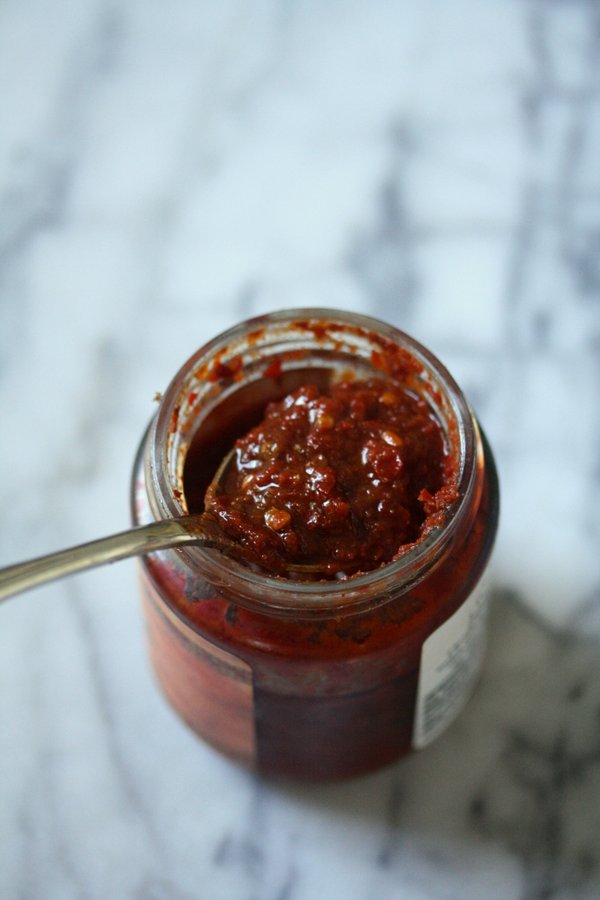
I decided to take on the no-microwave experiment mainly to evaluate my habits and see, as someone who cooks a lot and eats a lot of leftovers, exactly how reliant on nuking I was.
In my research though, I discovered some things that surprised me.
While the risk of radiation is real, and you should avoid using plastic so as not to leach BPA into your meal, as a machine used purely for heating food, the microwave is not the death box that everything thinks it is. And it doesn’t necessarily diminish the nutritional value of your food as so many eco-minded eaters have lead me to believe.
First, let’s try to brush off our 8th grade chemistry textbooks and understand how the microwave works.
Food gets heated by energy waves that target water and other molecules that are electrically asymmetrical. By converting these into thermal energy, the microwave basically steams your food from the inside out.
One thing that everyone should realize is that cooking food, in the microwave or otherwise, automatically reduces its nutritional value. But it’s the methods that heat food the quickest and use as little water as possible, that keep the most vitamins and minerals inside your meals. Because of this, steaming is the best method of cooking anything. And therefore, as far as nutrition goes, both staunch naturopath Dr. Weil and the country’s top medical school agree that the microwave is actually your food’s friend.
But while everyday reheating may not be such a bad thing, the problem with the microwave is the habit it fosters of making peel-and-eat dinners instead of real food. Since I live in New York City, my version of this lazy man’s dinner is ordering Thai takeout (which arrives steaming hot in a plastic, BPA filled container).
Knowing that I would have to dirty some dishes in order to prepare my leftovers definitely made me less likely to order a vat of chicken curry or jumbo-sized portion of stir fried noodles.If I was going to be adding to that sink of crusty soup bowls anyway, I might as well make something fresh. And because of this, I could see how killing the microwave might help you kill the habit of picking up packaged meals at the grocery store—the canned soups, frozen pizzas and ramen packets.
If you’re in this camp, the idea of the $40 Farmer’s Market Challenge–i.e. shopping and cooking 5 meals every Saturday or Sunday for the week ahead–is probably a more stressful prospect than a pop quiz administered by your in-laws in a TSA holding cell.
But giving up frozen dinners doesn’t necessarily mean that you can’t buy any packaged foods. I’m all about cutting corners if it allows you to spend some time at the stove instead of browsing Seamless—especially for those who are new to cooking. There’s a spectrum for what you buy in the supermarket aisles. The difference is between effort-free fixes, like frozen lasagna, and gateway cooking products, like jarred tomato sauce and a box of spaghetti.
Any product that gets you involved—even if it’s only by way of heating up a pot of water for pasta—is better than picking up the phone to order takeout or popping a frozen burrito in the microwave. As silly as it sounds, even heating up leftover takeout Pad Thai in a skillet does something for your relationship to the kitchen.
Cooking is a habit forming activity just like going to the gym. The microwave ban is a baby step towards the commitment to cook. It’s a beginner habit that can lead to so much more. I think you’ll find that the food tastes better, even if it’s no more nutritious.
Now, on the other hand, if you do cook all the time and make a habit of preparing meals for the week in advance, as The Farmer’s Market Challenge forced me to do, not having the convenience of the microwave is a HUGE pain in the ass—one that might make you more likely to want to go out to eat or get takeout in the first place. So after my experience this month, I don’t think I’m going to use the microwave much less. I already wash more dishes than I’d like to for a living. And yet, there are still always more soup bowls than I’d like in my sink.
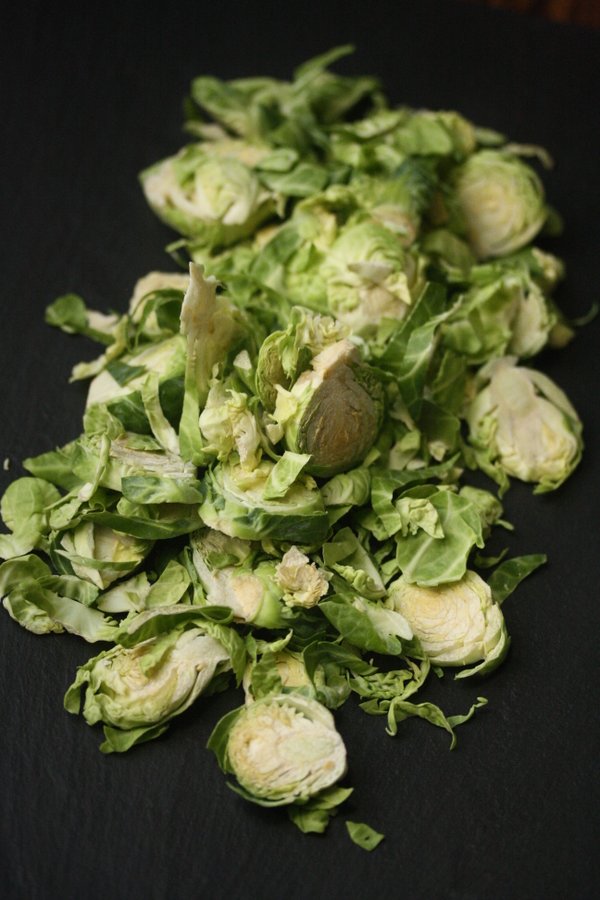
It’s so much harder to eat less meat than it is to simply be a vegetarian. Like with most diets, people have an easier time with strict guidelines and restrictions. Indulgence is a slippery slope.
But strictness is often what also makes diets hard to maintain over time, and vegetarian/veganism is no different.
10 percent of the population has tried going vegetarian at some point. And according to a study by the Humane Research Council, 84 percent of these well-intentioned non-meat eaters eventually go back to eating animals.
My favorite part about the VB6 program was that it married well with my philosophy of eating a lot of good with a little bad, and, more importantly, emphasized healthy choices without removing the joy of eating good food. It’s a give and take that allows you to maintain your well-being—something that counting pounds or calories will never do.
That said, I tried VB6 with very imperfect results.
Breakfast was perhaps the most difficult meal of the day to go vegan for. So I decided to make an exemption clause for eggs. For the most part, I eat breakfast at home and eggs are one of the most accessible animal products to find higher quality, organic versions of without paying a premium. So my experiment turned into V-egg-an Before Six.
Even with this modification though, I still cheated a handful of times.
The times I failed were mostly over the weekend when Charlie went to fire up his requisite Sunday bacon and I didn’t have the heart to tell him I wouldn’t eat my usual 3 slices. Or, rather, perhaps I was just a little worried about what would happen to his heart when he then ate all 6.
But really, a meal just isn’t as fun when you’re not enjoying the experience together. It’s why detox-retox month was so hard for both Charlie and myself. I never wanted to feel that way again, so I ate the bacon.
The other times I slipped were when I had leftover meatballs or chili from dinner that I wanted to use for lunch the next day. It seemed silly to order takeout just to keep vegan. So I would try to eat animal-free for dinner that night. When I did the final tally, I netted out in the animal-free green for the two week period. See what I made, here.
Doing VB6 made me realize how much I’ve already begun eating less meat over the years. It’s been a central part of cooking more from home and trying to spend less money doing so. Which brings me to the Farmer’s Market Challenge.
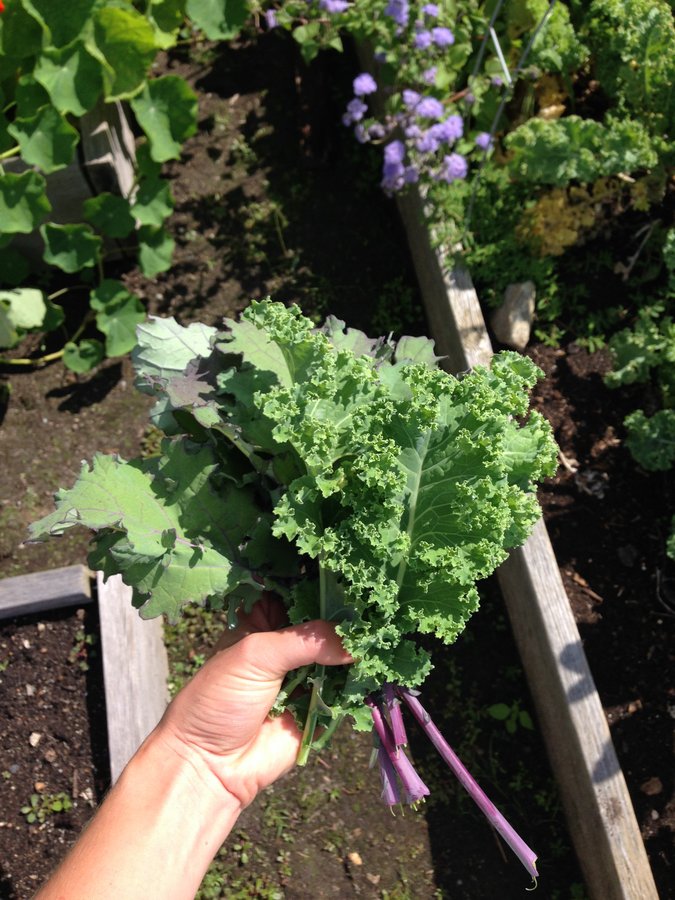
For a lot of people, including myself, the Farmer’s Market can be a money pit. Between the bespoke jams and artisanal duck prosciutto, it’s easy to leave having spent everything in your wallet, with your bag full of impulse buys that are a far cry from the building blocks of a meal.
One of the main problems of course with buying local and organic is access. I prototyped the FMC at the Union Square Farmer’s Market, which has the benefit of being incredibly robust, if also criminally expensive. BUT I got to prove that this challenge was not just the pipe dream of a jaded New Yorker, by trying it out during the two weeks I spent in Sewanee, Tennessee this month. It was definitely a taste of what the rest of the country is up against. Let’s just say the Piggly Wiggly is a far cry from Whole Foods!
I ended up having to modify and do the challenge in the main grocery aisle. I bought some organic boxed spinach, carrots and cabbage. But that was it for the Pig’s selection. So I stuck with other veggies that fall in the Clean 15 category–crops that don’t require a lot of pesticides to grow well (cauliflower), or don’t absorb the chemicals (avocados). There was only one measly option for organic meat (a 12 ounce round of frozen ground turkey), so I ended up eating mostly vegetarian, even at night. Here’s a list of menus that I made.
In general, the Farmer’s Market Challenge forced me to eat less meat. To make the $40 stretch, I really could only invest in 1 pound for the week. I ended up using it as a seasoning (like in my turkey minestrone), or limiting myself to one meat centric dish (healthy sesame chicken with broccoli) and using grains and veggies to round out my plate. Another tactic was to buy cheaper varieties — like bluefish, ground pork, or slow-braising beef shanks.
One of the on-going problems with making better quality meat more widely available is that we’ve become too obsessed with certain cuts. Unfortunately, a cow is not made up of filet Mignon. This is one of the points that Anya Fernald, CEO of Belcampo, a sustainable meat company in California, makes in a recent article from The New Yorker food issue. Part of her mission involves educating consumers about the lesser known parts of the animal that are equally delicious and easy to cook.
Eating seafood that is healthy for you and poses limited environmental risk is perhaps even trickier than sourcing sustainable meat. Just as beef tenderloin doesn’t account for the other 97 percent of the animal, the ocean is not made up entirely of salmon and shrimp. There are many nutritious wild fish that most Americans have never even eaten.
Because of this, the diversity in our oceans has begun to mirror our taste in seafood. The amount of shrimp we eat today–more than the next two most popular sea eats, (canned tuna and salmon) combined–is equivalent to our per capita oyster consumption a century ago. We’ve depleted a lot of the wild reserve of these species, and ignored other healthy choices in the process.
According to both EWG and Seafood Watch, the best items for Omega-3’s, low mercury and environmental impact are mollusks (clams, mussels, oysters, and scallops), and smaller oily fish like sardines and anchovies.
Butchers and fishermen at the Farmer’s Market need to sell the whole cow and smaller fish in their bycatch in order to make a living. One benefit of this budget challenge is that it can force you to explore the less sought after sections of these counters and discover some delicious, cheap items for the long term.
Besides diversifying your meat and seafood intake, I discovered a few other ways that the FMC will actually save you money.
First, seasonal local produce is also often times cheaper than something flown in from halfway around the world in the regular grocery aisle. You can get a whole head of broccoli and a bunch of kale for the price of one bell pepper in March.
Second, when you throw away food, you’re literally flushing your money down the toilet. You’re much less likely to toss the fruits of your labor than a half-eaten container of sad looking moo shu pork that it took you 30 minutes to source. And when you invest in higher quality perishable ingredients, you have an even bigger financial incentive to not let them die a slow death in your crisper drawer.
The beauty of planning ahead and cooking all your meals in one afternoon means you won’t have the scraps that make so many beginner home cooks feel wasteful when they first get started in the kitchen. It forces you to cook smarter, not harder–to buy fewer veggies and use them start to finish.
Most importantly, the challenge should inspire you to cook more simply. Not every meal you make at home has to feel like a Top Chef worthy production, or something that the Minimalist Pixie Dream Girl would post on instagram.
It’s great to whip up a special dinner every now and then. But getting in the habit of cooking means learning to embrace and reuse leftovers. Packing a lot of dishes into one cooking session, means learning to love some of the humble one-pot recipes that make up so many ethnic cuisines. The beauty of farmer’s market produce is that you don’t need to gild the lily to make it delicious.
Roasted vegetables with olive oil and sea salt is one of the simplest and most delicious recipes on earth. And that’s the kind of cooking ritual this lazy, healthy not-so-dreamlike food blogger can get behind.
The Wellness Project is now a book! It’s part memoir, part health primer, with 20 inflammation fighting recipes for clearer skin, better digestion, and a thriving thyroid. (Because who doesn’t wake up in the morning wanting a thriving thyroid?!). You can read more and preorder here. To read up on past experiments and get more tips from the trenches, click here.
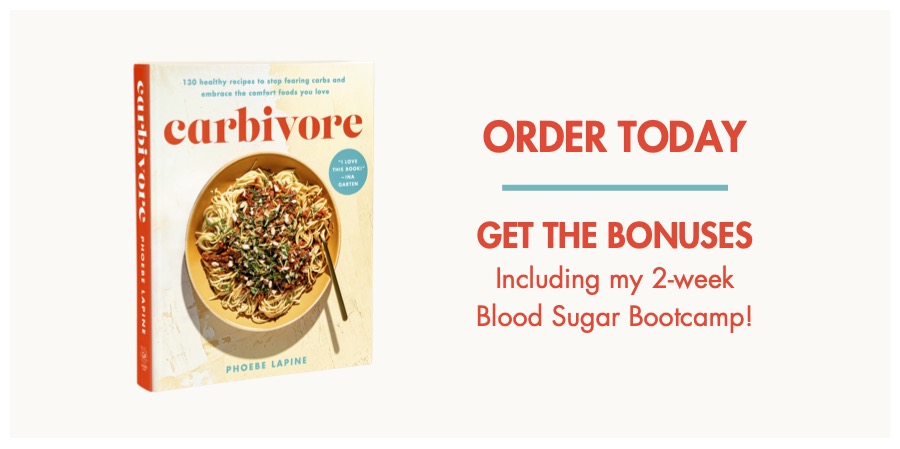
I think we should hold Minimalist Pixie Dream Girl down and put a funnel in her mouth and dump your fabulous turkey chili down her throat. That would take care of the white sheets too.
what a visual!